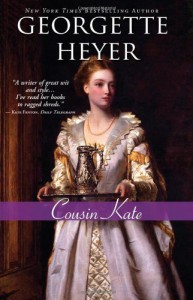
My main gripe with "Cousin Kate" was its length, but having said that, the description of life and the way people lived and interacted is worth exploring. Perhaps it's more a reflection of the pace I've come to expect in more modern books.What sets this one apart from her other Regency novels is the character of Torquil who is, to me, the star of the book.Try reading this, taking into account modern days attitude to madness and psychiatry. This is in the time before Fluoxetine and Olanzapine. Where people were diagnosed as simply "mad" and locked away. The nature of their illness was often hidden away from neighbours and the public, with the burden of looking after them left to family or trusted retainers. The illness itself was not understood and rightly feared. Sometimes inbreeding contributed to the problem.Depression, schizophrenia, manic depression, at times Torquil shows signs of all three. This, of course, lends itself to a Gothic style novel, much in the style of Emily Bronte, but the real tragedy lies in the fact that society and the medical profession of the era did not know how to handle these cases. Instead, people had to walk on eggshells, trying to cope with the situation, the only recourse being sedatives.Balanced by this is the "madness" that Torquil's mother exhibits. Her obsession and determination to get her own way all in the name of protecting the legacy.There is still a lot that needs to be done with mental health, but at least we have progressed beyond the stage depicted here.Given that Georgette Heyer's least popular books are those where she explores serious subjects rather than just romances, I'd be interested to know her reasons for writing this one.
 My main gripe with "Cousin Kate" was its length, but having said that, the description of life and the way people lived and interacted is worth exploring. Perhaps it's more a reflection of the pace I've come to expect in more modern books.What sets this one apart from her other Regency novels is the character of Torquil who is, to me, the star of the book.Try reading this, taking into account modern days attitude to madness and psychiatry. This is in the time before Fluoxetine and Olanzapine. Where people were diagnosed as simply "mad" and locked away. The nature of their illness was often hidden away from neighbours and the public, with the burden of looking after them left to family or trusted retainers. The illness itself was not understood and rightly feared. Sometimes inbreeding contributed to the problem.Depression, schizophrenia, manic depression, at times Torquil shows signs of all three. This, of course, lends itself to a Gothic style novel, much in the style of Emily Bronte, but the real tragedy lies in the fact that society and the medical profession of the era did not know how to handle these cases. Instead, people had to walk on eggshells, trying to cope with the situation, the only recourse being sedatives.Balanced by this is the "madness" that Torquil's mother exhibits. Her obsession and determination to get her own way all in the name of protecting the legacy.There is still a lot that needs to be done with mental health, but at least we have progressed beyond the stage depicted here.Given that Georgette Heyer's least popular books are those where she explores serious subjects rather than just romances, I'd be interested to know her reasons for writing this one.
My main gripe with "Cousin Kate" was its length, but having said that, the description of life and the way people lived and interacted is worth exploring. Perhaps it's more a reflection of the pace I've come to expect in more modern books.What sets this one apart from her other Regency novels is the character of Torquil who is, to me, the star of the book.Try reading this, taking into account modern days attitude to madness and psychiatry. This is in the time before Fluoxetine and Olanzapine. Where people were diagnosed as simply "mad" and locked away. The nature of their illness was often hidden away from neighbours and the public, with the burden of looking after them left to family or trusted retainers. The illness itself was not understood and rightly feared. Sometimes inbreeding contributed to the problem.Depression, schizophrenia, manic depression, at times Torquil shows signs of all three. This, of course, lends itself to a Gothic style novel, much in the style of Emily Bronte, but the real tragedy lies in the fact that society and the medical profession of the era did not know how to handle these cases. Instead, people had to walk on eggshells, trying to cope with the situation, the only recourse being sedatives.Balanced by this is the "madness" that Torquil's mother exhibits. Her obsession and determination to get her own way all in the name of protecting the legacy.There is still a lot that needs to be done with mental health, but at least we have progressed beyond the stage depicted here.Given that Georgette Heyer's least popular books are those where she explores serious subjects rather than just romances, I'd be interested to know her reasons for writing this one.



